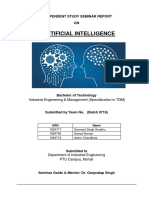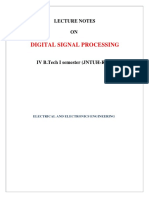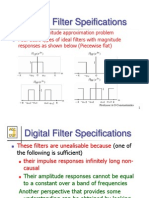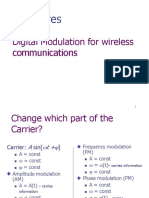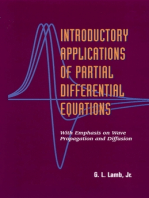Sampling and Reconstruction
Uploaded by
Huynh BachSampling and Reconstruction
Uploaded by
Huynh BachDIGITAL SIGNAL PROCESSING
Lectured by Assoc. Prof. Dr. Thuong Le-Tien
National distinguished Lecturer
Tel: 0903 787 989, email: thuongle@hcmut.edu.vn
Sept, 2011
Sampling and Reconstruction
Sampling and Reconstruction
1. Introduction
2. Overview of Analog
3. Sampling theorem
4. Sampling of Sinusoids
5. Spectra of Sampled
6. Analog signal reconstruction
2
Three steps for digital signal processing of
analog signals
Step 1: Digitizing of analog signals:
Sampling, Quantization Analog to Digital
Conversion (ADC).
Step 2: Implementing digital signal
processor for discrete samples
Step 3: Reconstructing the analog signal
after processing Digital to Analog
Conversion (DAC)
3
1. Introduction
FOURIER Transform X(O) of x(t) is the spectrum of the
analog signal:
(2.1)
Where O is the radian frequency (rad/s).
and O = 2tf (2.2)
Definition of Laplace Transform:
(2-3)
4
2. Review of Analog signals
dt e t x X
t jO
}
= O ) ( ) (
dt e t x s X
st
}
= ). ( ) (
Response of a linear system
The system is characterized by impulse response h(t). The
output y(t) is obtained by the time domain convolution :
Or frequency domain:
where H(O) is the frequency response of the system.
5
' ) ' ( ) ' ( ) (
}
= dt t x t t h t y
) ( ). ( ) ( O O = O X H Y
Linear system
h(t)
x(t)
input
y(t)
output
H(O) is the Fourier transform of h(t)
The steady state response of a sinusoid:
Output is a sinusoid with frequency (O),
amplitude equal to the signal amplitude multiplied
by MagH(O), and phase shift equal to arg(H(O)):
6
}
O
= O dt e t h H
t j
) ( ) (
Linear system
H(O)
x(t) = exp(jOt)
Sinusoid in
y(t) = H(O)exp(jOt)
Sinusoid out
) ( arg
. | ) ( | ) ( ) ( ) (
O + O O O
O = O = =
H j t j t j t j
e H e H t y e t x
Linear superposition: Signals x(t) has two frequency
components
After filtering
Note: Filtering only change the magnitudes but not
the frequencies
7
t j t j
e A e A t x
2 1
2 1
) (
O O
+ =
t j t j
e H A e H A t y
2 1
) ( ) ( ) (
2 1
O O
O + O =
The result is presented in frequency domain
Spectrum of X(O)
Spectrum of Y(O)
8
X( O)
A
1
A
2
H( O)
O
Y( O)
A
1
H( O)
O
A
2
H( O)
) ( 2 ) ( 2 ) (
2 2 1 1
O O + O O = O o t o t A A X
) ( ) ( 2 ) ( ) ( 2
)) ( 2 ) ( 2 )( ( ) ( ) ( ) (
2 2 2 1 1 1
2 2 1 1
O O O + O O O =
O O + O O O = O O = O
o t o t
o t o t
H A H A
A A H X H Y
Sampling process in Fig. 3.1. x(t) is sampled
by period T, t=nT where n=0,1,2,
Many high frequency components appear
in the signal spectrum
Two questions are often provided for
1. What is the effect of sampling on the
original frequency spectrum?
2. How should one choose the sampling
interval T?
9
3. Concept of Sampling theorem
The spectrum of the sampled sinusoid x(nT)
will be periodic replication of the original
spectral line at intervals f
s
=1/T
Figure 3.1 Ideal Sampler
10
11
Figure 3.2. Spectrum replication caused by sampling.
With the replicated spectrum of the sampled signal, one
cannot tell uniquely What the original frequency was. It
could be any one of the replicated frequencies namely
f=f+mf
s.
This potential confusion of the original frequency
with another is known as aliasing and can be avoided if one
satisfies the condition of the sampling theorem
Sampling theorem
For accurate representation of a signal x(t) by its
time samples x(nT), two conditions must be met:
1: x(t) is bandlimited
2: Sampling frequency must be chosen to be
at least twice the maximum frequency f
max
,
f
s
> 2f
max
:
f
s
= 2f
max
is the Nyquist rate.
f
s
/2 is the Nyquist frequency or folding
frequency
12
Typical sampling rate for some common applications
Antialiasing Prefilter
Signal must be bandlimited therefore need to pass
through a low pass filter namely prefilter before sampling
14
Prefiltered spectrum
0
0 - f
s
f
s
f
f
- f
s
/2 f
s
/2
f
Input spectrum
prefilter
Replicated
spectrum
Bandlimited
signal
x(t) Analog
signal
digital
signal
x( nT) x(t)
Analog lowpass
filter
Sampler and
quantizer
To DSP
Antialiasing prefilter
What happens if we do not sample in
accordance with the sampling theorem?
Missing important time variations between sampling instants
May arrive at the erroneous conclusion that the samples
represent a signal which is smoother than it actually is
Be confusing the true frequency content of the signal with a
lower frequency content. Such confusion of signals is called
aliasing
Aliasing in
The time domain
The number of samples per is given by the quantity f
s
/f:
16
4. Sampling of sinusoid: x(t) = cos(2tft)
cycle
samples
cycles
samples
f
f
s
= =
sec /
sec /
Special case with multiple frequency components in the x(t)
17
Analog reconstruction and aliasing
) ( ) (
2 2 2 ) ( 2
nT x e e e e nT x
jfTn Tn jmf jfTn Tn mf f j
m
s s
= = = =
+ t t t t
,... ,..., 2 , ,
s s s
mf f f f f f f
Using the property f
s
T=1 and the trigonometric identity
Define also the following family of sinusoids, for m in integer
And its sampled version
Note that x
m
(t) are different from each other
but they have same samples:
18
LPF as an ideal
reconstructor
Example
As sinusoid f=10 Hz, sampled by f
s
=12Hz. The sampled
signal consists of periodic frequencies 10+m.12Hz, m = 0,
1, 2, or: , -26, -14, -2, 10, 22, 34, 46, but only f
a
= 10 mod(12) = 10 12 = -2 Hz in the range of Nyquist
interval [-6,6] Hz. So the reconstructed signal with 2 Hz
is not as the original one with 10 Hz.
19
Example: 5 signals are sampled by the rate 4Hz:
(t second)
Let prove they are aliased each other due to their same
samples.
Sol: The frequencies of the signals: -7, -3, 1, 5, 9 Hz. They
have the same periodic replication in multiples of f
s
=4Hz.
Writing the five frequencies compactly:
f
m
=1+4m, m=-2, -1, 0, 1, 2.
20
t) sin(18 t), sin(10 t), sin(2 , ) 6 sin( ), t 14 sin( t t t t t t
2 -2,-1,0,1, m )), 4 1 ( 2 sin( ) 2 sin( ) ( = + = = n t f t x
m m
t t
) 4 / 2 sin( ) 2 4 / 2 sin(
) 4 / ) 4 1 ( 2 sin( ) ) 4 1 ( 2 sin( ) (
n mn n
n m nT m nT x
m
t t t
t t
= + =
+ = + =
Example: x(t)=4+3cos(pt)+2cos(2pt)+cos(3pt) t: in ms
Determine the min sampling rate without any aliasing effects
Supposed the signal sampled at half its Nyquist rate.
Determine xa(t) that would be aliased with x(t).
Sol:
Freq. of 4 terms: f
1
=0, f
2
=0.5kHz, f
3
=1kHz,f
4
=1.5kHz
Example: The square wave sampled at rate f
s
; t in seconds
Determine the x
a
(t) that will appear at the output of the
reconstructor for 2 cases f
s
=4kHz and 8kHz.
Sol:
Fourier series of square wave contains odd harmonics at freq.
For f
s
=4kHz, the aliased signal will be
For fs =8kHz, the aliased signal will be
The first case: Sketch for x
a
(t)
Condition x
a
(t)=x(nT) evalued at n=1 implies A=1
The second case: x
a
(t)=Bsin(tn/4)+Csin(3tn/4)
Condition x
a
(t)=x(nT) at n=1,2 give two equations
Example: A given x(t), t in ms and a block of DSP
Determine the y(t) and y
a
(t) in the following cases:
a. When there is no prefilter, that is, H(f)=1 for all f
b. When H(f) is the ideal filter with cutoff f
s
/2=20kHz
c. When H(f) is a practical prefilter as follows,
Sol: Six terms of freq. in x(t)
Case a.
Case b.
Case c.
Sampled signal:
In practical sampling, the sampled signal:
where, p(t) is flat-top pulse of duration t second.
Ideal sampling with t toward 0.
30
5. Spectra of sampled signals
=
=
n
nT t nT x t x ) ( ) ( ) (
=
=
n
flat
nT t p nT x t x ) ( ) ( ) (
0 T 2T . nT t
0 T 2T . nT t
x flat (t)
t
) ( t x
) ( ) ( nT t nT x o
) ( ) ( nT t p nT x
Discrete Time Fourier Transform DTFT
or
This approximation become exact if
Practical approximation
32
Spectrum Replication
Aliasing caused by overlapping spectral replicas
Ideal antialiasing prefilter
Practical antialiasing prefilter
Attenuation in dB
35
6. Analog signal reconstruction
Staircase reconstructor
Analog reconstructor as a low pass filter
) (
) ( ) ( f Y f H f Y
a
=
+
=
=
n
a
nT t h nT y t y ) ( ) ( ) (
) (
1
) (
=
=
m
s
mf f Y
T
f Y
36
+
=
=
n
nT t nT y t y ) ( ) ( ) (
+
=
=
n
a
nT t h nT y t y ) ( ) ( ) (
Replicated spectrum
Reconstructed analog signal
Ideal reconstructor
Staircase reconstructor
Anti-image postfilter
Digital equalization filter for D/A conversion
You might also like
- Bomag Hypac C766 C C778 B Workshop Service Repair Manual Download100% (2)Bomag Hypac C766 C C778 B Workshop Service Repair Manual Download602 pages
- Solutions Introduction To Signal Processing100% (4)Solutions Introduction To Signal Processing148 pages
- Advanced Topics in Digital Signal ProcessingNo ratings yetAdvanced Topics in Digital Signal Processing23 pages
- Signal Processing First Reading Assignments: This LectureNo ratings yetSignal Processing First Reading Assignments: This Lecture9 pages
- Design and Analysis of A Symmetric Phase Locked Loop For Low Frequencies in 180 NM TechnologyNo ratings yetDesign and Analysis of A Symmetric Phase Locked Loop For Low Frequencies in 180 NM Technology6 pages
- An Overview of Design Techniques For CMOS Phase DetectorsNo ratings yetAn Overview of Design Techniques For CMOS Phase Detectors4 pages
- Phase Noise and Jitter in CMOS Ring OscillatorsNo ratings yetPhase Noise and Jitter in CMOS Ring Oscillators14 pages
- Chapter 08 (Electronic Devices and Circuits-II)No ratings yetChapter 08 (Electronic Devices and Circuits-II)59 pages
- Gobind Daryanani Principles of Active Network PDFNo ratings yetGobind Daryanani Principles of Active Network PDF255 pages
- ECE 4316: Digital Signal Processing: Dr. Hany M. ZamelNo ratings yetECE 4316: Digital Signal Processing: Dr. Hany M. Zamel23 pages
- Image Processing Compression TechniquesNo ratings yetImage Processing Compression Techniques16 pages
- Statistical Signal Processing: ECE 5615 Lecture Notes Spring 201 9No ratings yetStatistical Signal Processing: ECE 5615 Lecture Notes Spring 201 932 pages
- RTS Noise Impact in CMOS Image Sensors Readout CircuitNo ratings yetRTS Noise Impact in CMOS Image Sensors Readout Circuit5 pages
- Principle of Communications BP Lathi SolutionsNo ratings yetPrinciple of Communications BP Lathi Solutions155 pages
- DLL Design Examples, Design Issues - TipsNo ratings yetDLL Design Examples, Design Issues - Tips56 pages
- Digital Modulation For Wireless CommunicationsNo ratings yetDigital Modulation For Wireless Communications72 pages
- The Fast Fourier Transform: (And DCT Too )No ratings yetThe Fast Fourier Transform: (And DCT Too )36 pages
- Stein J.Y. Digital Signal Processing - A Computer Science Perspective (Wiley, 2000) (T) (869s)100% (1)Stein J.Y. Digital Signal Processing - A Computer Science Perspective (Wiley, 2000) (T) (869s)869 pages
- Digital Signal Processing Lecture Notes - 22nov2010 - v4No ratings yetDigital Signal Processing Lecture Notes - 22nov2010 - v411 pages
- Ultra-Low Power SAR-ADC in 28nm CMOS TECHNo ratings yetUltra-Low Power SAR-ADC in 28nm CMOS TECH86 pages
- ECE 4316: Digital Signal Processing: Dr. Hany M. ZamelNo ratings yetECE 4316: Digital Signal Processing: Dr. Hany M. Zamel23 pages
- Ch03 - Fourier Representations of Signals LTI Systems PDFNo ratings yetCh03 - Fourier Representations of Signals LTI Systems PDF201 pages
- Fixed Point Signal Processing by W Paddget100% (1)Fixed Point Signal Processing by W Paddget133 pages
- Advanced Engineering Math - Fourier Analysis of CTSS PDFNo ratings yetAdvanced Engineering Math - Fourier Analysis of CTSS PDF79 pages
- Introductory Applications of Partial Differential Equations: With Emphasis on Wave Propagation and DiffusionFrom EverandIntroductory Applications of Partial Differential Equations: With Emphasis on Wave Propagation and DiffusionNo ratings yet
- Transmission Lines in Digital and Analog Electronic Systems: Signal Integrity and CrosstalkFrom EverandTransmission Lines in Digital and Analog Electronic Systems: Signal Integrity and CrosstalkNo ratings yet
- Nonnegative Matrices and Applicable Topics in Linear AlgebraFrom EverandNonnegative Matrices and Applicable Topics in Linear AlgebraNo ratings yet
- Silica Optical Fiber Technology for Devices and Components: Design, Fabrication, and International StandardsFrom EverandSilica Optical Fiber Technology for Devices and Components: Design, Fabrication, and International StandardsNo ratings yet
- Optical and Microwave Technologies for Telecommunication NetworksFrom EverandOptical and Microwave Technologies for Telecommunication NetworksNo ratings yet
- Lesson 1: Determination of Sugar As Glucose: I-Reaction Equation0% (1)Lesson 1: Determination of Sugar As Glucose: I-Reaction Equation3 pages
- ECE 330 Homework Assignment #5, Due On Friday, May 16, 2014No ratings yetECE 330 Homework Assignment #5, Due On Friday, May 16, 20141 page
- ECE 330 Homework Assignment #7, Due in Final ExaminationNo ratings yetECE 330 Homework Assignment #7, Due in Final Examination1 page
- ECE 330 Homework Assignment #4, Due in Mid-Term Examination: Problem 1No ratings yetECE 330 Homework Assignment #4, Due in Mid-Term Examination: Problem 11 page
- ECE 330 Homework Assignment #6, Due On Friday, May 30, 2014No ratings yetECE 330 Homework Assignment #6, Due On Friday, May 30, 20141 page
- ECE 330 Homework Assignment #3, Due On Friday, March 21, 2014No ratings yetECE 330 Homework Assignment #3, Due On Friday, March 21, 20141 page
- ECE 330 Homework Assignment #2, Due On Friday, March 7, 2014No ratings yetECE 330 Homework Assignment #2, Due On Friday, March 7, 20142 pages
- ECE 330 Homework Assignment #1, Due On Friday, February 21, 2014No ratings yetECE 330 Homework Assignment #1, Due On Friday, February 21, 20141 page
- Analysis of Linear Time Invariant SystemsNo ratings yetAnalysis of Linear Time Invariant Systems32 pages
- Fourier Transform and Fast Fourier Transform AlgorithmsNo ratings yetFourier Transform and Fast Fourier Transform Algorithms42 pages
- Distributing Services Through Physical and Electronic Channels 2 ND P: Place and TimeNo ratings yetDistributing Services Through Physical and Electronic Channels 2 ND P: Place and Time37 pages
- Day in The Life of A Proactive Maintenance PlannerNo ratings yetDay in The Life of A Proactive Maintenance Planner64 pages
- Birth Death Registration Portal User Manual For Citizen - v1.0No ratings yetBirth Death Registration Portal User Manual For Citizen - v1.066 pages
- IATA Airport Development Reference Manual JAN 200483% (18)IATA Airport Development Reference Manual JAN 2004724 pages
- Quotation For IATF Awareness Training Onsite PDF100% (1)Quotation For IATF Awareness Training Onsite PDF3 pages
- Project Name: IC Engine Simulation: Pankaj Dohale (202180028) Project byNo ratings yetProject Name: IC Engine Simulation: Pankaj Dohale (202180028) Project by10 pages
- Ethical Hacking and Defence Part-Ii Lab ProjectNo ratings yetEthical Hacking and Defence Part-Ii Lab Project19 pages
- How To Separate User Engagement From DistractionNo ratings yetHow To Separate User Engagement From Distraction3 pages
- 26 05 73 Short Circuit Analysis-Coord StudyNo ratings yet26 05 73 Short Circuit Analysis-Coord Study8 pages
- Bomag Hypac C766 C C778 B Workshop Service Repair Manual DownloadBomag Hypac C766 C C778 B Workshop Service Repair Manual Download
- Signal Processing First Reading Assignments: This LectureSignal Processing First Reading Assignments: This Lecture
- Design and Analysis of A Symmetric Phase Locked Loop For Low Frequencies in 180 NM TechnologyDesign and Analysis of A Symmetric Phase Locked Loop For Low Frequencies in 180 NM Technology
- An Overview of Design Techniques For CMOS Phase DetectorsAn Overview of Design Techniques For CMOS Phase Detectors
- ECE 4316: Digital Signal Processing: Dr. Hany M. ZamelECE 4316: Digital Signal Processing: Dr. Hany M. Zamel
- Statistical Signal Processing: ECE 5615 Lecture Notes Spring 201 9Statistical Signal Processing: ECE 5615 Lecture Notes Spring 201 9
- RTS Noise Impact in CMOS Image Sensors Readout CircuitRTS Noise Impact in CMOS Image Sensors Readout Circuit
- Stein J.Y. Digital Signal Processing - A Computer Science Perspective (Wiley, 2000) (T) (869s)Stein J.Y. Digital Signal Processing - A Computer Science Perspective (Wiley, 2000) (T) (869s)
- Digital Signal Processing Lecture Notes - 22nov2010 - v4Digital Signal Processing Lecture Notes - 22nov2010 - v4
- ECE 4316: Digital Signal Processing: Dr. Hany M. ZamelECE 4316: Digital Signal Processing: Dr. Hany M. Zamel
- Ch03 - Fourier Representations of Signals LTI Systems PDFCh03 - Fourier Representations of Signals LTI Systems PDF
- Advanced Engineering Math - Fourier Analysis of CTSS PDFAdvanced Engineering Math - Fourier Analysis of CTSS PDF
- Modulation and Coding Techniques in Wireless CommunicationsFrom EverandModulation and Coding Techniques in Wireless Communications
- Introductory Applications of Partial Differential Equations: With Emphasis on Wave Propagation and DiffusionFrom EverandIntroductory Applications of Partial Differential Equations: With Emphasis on Wave Propagation and Diffusion
- Transmission Lines in Digital and Analog Electronic Systems: Signal Integrity and CrosstalkFrom EverandTransmission Lines in Digital and Analog Electronic Systems: Signal Integrity and Crosstalk
- Nonnegative Matrices and Applicable Topics in Linear AlgebraFrom EverandNonnegative Matrices and Applicable Topics in Linear Algebra
- Silica Optical Fiber Technology for Devices and Components: Design, Fabrication, and International StandardsFrom EverandSilica Optical Fiber Technology for Devices and Components: Design, Fabrication, and International Standards
- Optical and Microwave Technologies for Telecommunication NetworksFrom EverandOptical and Microwave Technologies for Telecommunication Networks
- Introductory Laplace Transform with ApplicationsFrom EverandIntroductory Laplace Transform with Applications
- Lesson 1: Determination of Sugar As Glucose: I-Reaction EquationLesson 1: Determination of Sugar As Glucose: I-Reaction Equation
- ECE 330 Homework Assignment #5, Due On Friday, May 16, 2014ECE 330 Homework Assignment #5, Due On Friday, May 16, 2014
- ECE 330 Homework Assignment #7, Due in Final ExaminationECE 330 Homework Assignment #7, Due in Final Examination
- ECE 330 Homework Assignment #4, Due in Mid-Term Examination: Problem 1ECE 330 Homework Assignment #4, Due in Mid-Term Examination: Problem 1
- ECE 330 Homework Assignment #6, Due On Friday, May 30, 2014ECE 330 Homework Assignment #6, Due On Friday, May 30, 2014
- ECE 330 Homework Assignment #3, Due On Friday, March 21, 2014ECE 330 Homework Assignment #3, Due On Friday, March 21, 2014
- ECE 330 Homework Assignment #2, Due On Friday, March 7, 2014ECE 330 Homework Assignment #2, Due On Friday, March 7, 2014
- ECE 330 Homework Assignment #1, Due On Friday, February 21, 2014ECE 330 Homework Assignment #1, Due On Friday, February 21, 2014
- Fourier Transform and Fast Fourier Transform AlgorithmsFourier Transform and Fast Fourier Transform Algorithms
- Distributing Services Through Physical and Electronic Channels 2 ND P: Place and TimeDistributing Services Through Physical and Electronic Channels 2 ND P: Place and Time
- Day in The Life of A Proactive Maintenance PlannerDay in The Life of A Proactive Maintenance Planner
- Birth Death Registration Portal User Manual For Citizen - v1.0Birth Death Registration Portal User Manual For Citizen - v1.0
- IATA Airport Development Reference Manual JAN 2004IATA Airport Development Reference Manual JAN 2004
- Project Name: IC Engine Simulation: Pankaj Dohale (202180028) Project byProject Name: IC Engine Simulation: Pankaj Dohale (202180028) Project by
